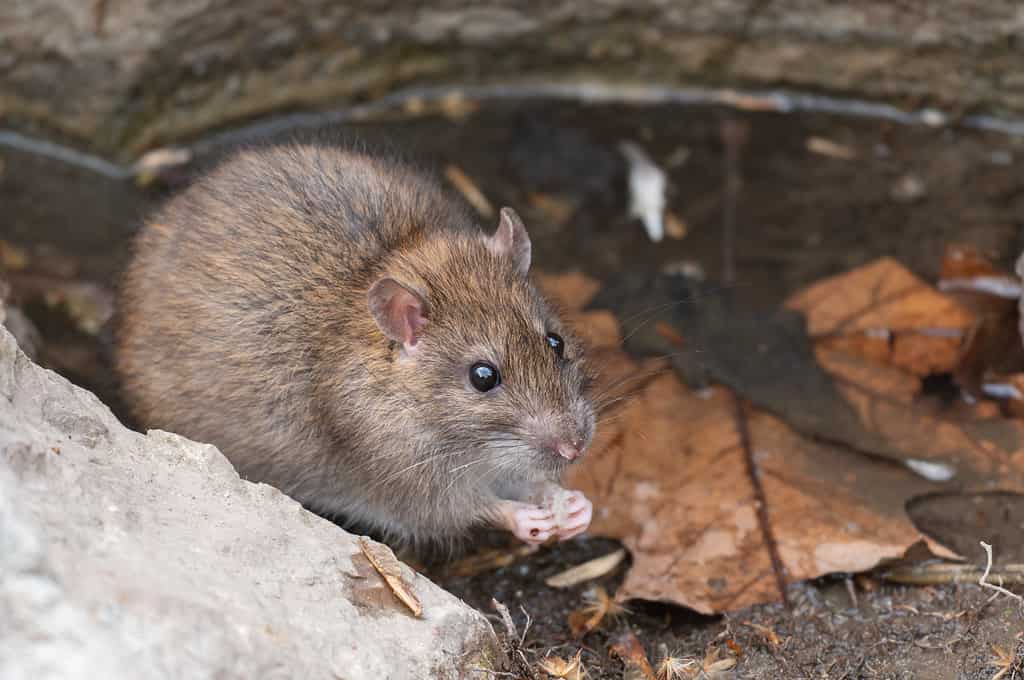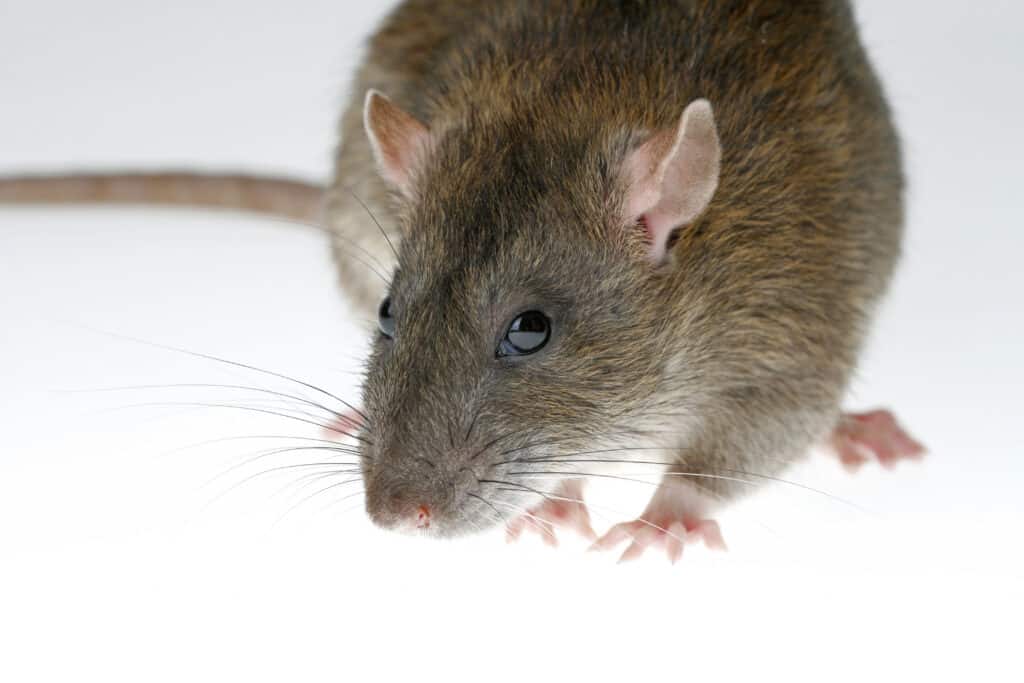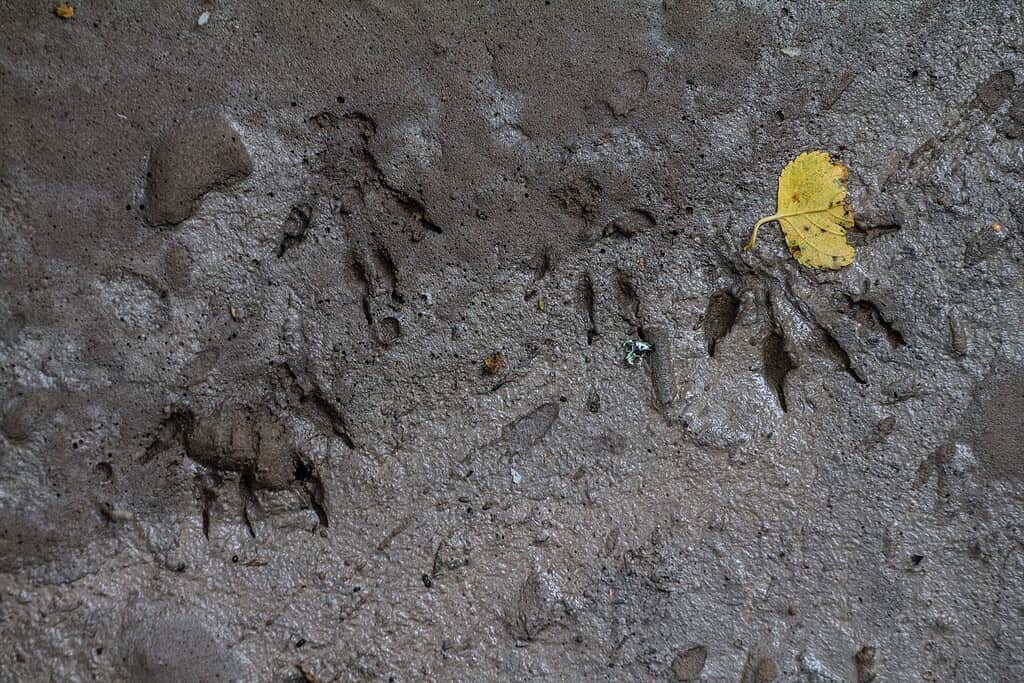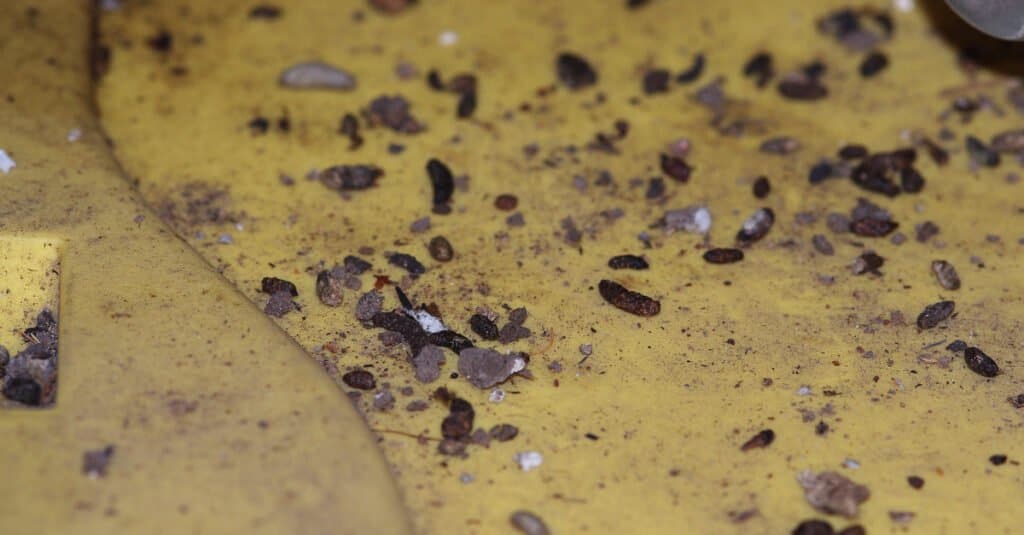If you find animal tracks in your garden, crawl space, or house, it can be helpful to identify what creature left them behind. Common pests in the United States include ants, cockroaches, mice, and rats, all of whom may leave clues of their presence. If you’re worried that you may have new rat residents, you are in the right place. This article will explore rat tracks and ensure you can identify these pests and get them out of your home.

The small front paws of a brown rat have long fingers.
©iStock.com/MriyaWildlife
Animal Background
Description

A Norway rat is a common species belonging to the genus
Rattus. It is one of the most populous rat species in the world.
©JaklZdenek/Shutterstock.com
Rats are small mammals that belong to the order Rodentia. Typical rat species belong to the genus Rattus which includes 64 species living today. Adult rats range in weight from 200 to 500 grams (about 7 to 18 ounces). Rats in urban areas tend to be larger than individuals in suburban areas or the wild. This is in part due to having a more consistently available food supply, even during the winter. The most common species is the brown rat, Rattus norvegicus. This species is also colloquially known as the common rat, sewer rat, street rat, Norwegian rat, and Norway rat. Brown rats have bodies approximately 6 to 11 inches long and bald tails between 4.25 to 9.5 inches long. In total, brown rats are typically over 14 inches! They have several different fur color variations including shades from light brown to black.
Distribution

The Norway rat or brown rat is native to China, but due to human travel, they have been able to access ships and populate every continent except Antarctica.
©Holger Kirk/Shutterstock.com
The only rat-free continent is Antarctica. Brown rats specifically can be found around the world, as well. They are an example of an invasive species, which is an organism that has been introduced to a new ecosystem and proliferated in a way that disrupts the balance of that ecosystem. Brown rats originated in China or Mongolia and were present in Europe as early as 1553. They spread most rapidly following the industrial revolution and were present in North America by 1755. Today, brown rats are commonplace and the domesticated subspecies, Rattus norvegicus domestica (“fancy rats”), are also kept as pets.
Rats often inhabit human-developed areas because they can employ opportunistic scavenging. Life in the city entails easy access to human leftovers and easier predator avoidance. In cities, rats can often be found in trashcans, subway systems, sewage, and on the streets or in restaurants with poor sanitation. In the wild and in captivity, rats live in burrows that can develop into complex tunnel systems.
Rat Tracks
Paw Morphology
Rats have 4 paws that face forwards when they walk. Rats are plantigrade animals, meaning that their digits and palms are flat on the ground for each step. Their front paws produce a four-toed pawprint and their back paws produce a five-toed print. The hind paws leave prints that are notably longer than their front paws and their fingers and toes usually appear spread. Rats also often leave an impression from their large tail with their tracks. Their long claws may also be visible.
Snow

This illustration depicts the typical gait of a rat where paws alternate as they scurry. This is unlike squirrels or rabbits whose front paws and back paws move in pairs as they leap.
©Peter Hermes Furian/Shutterstock.com
Rats live in many areas that experience seasonal snowfall. They do not hibernate and are therefore active during the winter. Rats do reduce their activity during this season, however, and seek out warm and dry areas. Before the cold sets in, rats stockpile food so they can avoid the harsh winter conditions. Their tracks will be scarcer during winter than in warmer seasons. When they are found, rat prints are easy to identify because of the long drag mark that is left by their tails. The mark left by the tail may be more apparent in the snow than on other surfaces. Their characteristic four-toed front paws and five-toed back paws can often produce clear impressions in snow but details such as their claws may not be visible.
Mud and Dust

In these Norway rat tracks, the fingers of each pawprint are spread wide.
©Maximillian cabinet/Shutterstock.com
Rat tracks are typically most easily visible in muddy or dusty locations. Depending on the depth and consistency of the mud, individual digits and nails are often visible. Less detail is discernable if the ground is saturated. In dust, tracks are often clear and can indicate approximately how long ago the animal passed through an area. In crawl spaces or other dusty locations, fresh tracks and old tracks can be distinguished to assess where the rodents are currently inhabiting versus abandoned nest sites.
Other Identification Tools

Rat droppings are typically brown to black in color and are cylindrical or oval shaped.
©Photo – TMD/Shutterstock.com
Rats are known to establish foraging paths that they reuse extensively. When trying to identify rat tracks, look for any signs of chewing that might alert you to a foraging path. Another valuable tool for locating and identifying rat prints is excrement. Both urine and droppings indicate rat activity and are often left along active foraging paths. A third clue to look for when you suspect rats is the presence of rat holes. Rats are capable of chewing through wood, wires, and concrete. Check for rat holes near water pipes and cluttered areas that might attract rodents. Finally, since rats are burrowing animals, be on the lookout for nest sites, too. Rat nests, droppings, foraging paths, and chew marks are all good clues to use when identifying tracks.
Keeping Rats Away

Peppermint oil is an effective, nontoxic solution for evicting and deterring rats from your home.
©Madeleine Steinbach/Shutterstock.com
There are many ways you can handle a rat infestation or prevent one from happening. Although there are harmful traps and chemical deterrents readily available on the market, there are natural and less painful solutions as well. For example, peppermint oils have been used as a natural remedy for generations. There are also newer, high-tech options like ultrasonic solar animal repellent to keep pests away. Preventative measures can be taken to make your home a less attractive nesting site, as well. These include ensuring you garbage can lids are closed tightly, refraining from using birdfeeders or otherwise feeding wildlife, keeping dog food inside, and picking up fruits and vegetables in your yard. If food is available, rats will scavenge for it.
Fun Fact About Rat Control
An interesting fun fact about rats is that in Alberta, Canada, there is an armed rat patrol. An extensive government funded effort to eliminate rats from the province has been active since 1950. The armed rat patrol was enlisted to monitor provincial borders. Propaganda encouraging civilians to kill any rats they encountered was used to increase citizen involvement, as well. Today, Alberta is effectively rat free and prevention efforts are still enforced. Alberta’s rat control program is an example of how people are retaliating against invasive species that disrupt the area’s natural ecosystems.
The photo featured at the top of this post is © torook/Shutterstock.com
Thank you for reading! Have some feedback for us? Contact the AZ Animals editorial team.






